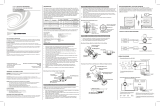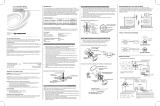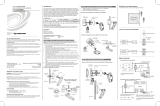Page is loading ...

Ultrasonic Ceiling Mounted Occupancy Sensor
Cat. No. OSC
Ø
5-U, OSC1
Ø
-U, OSC2
Ø
-U
To be used with 24VDC OSP
xx
Series and CN100 Power Pack Class II Low-Voltage Wiring
INSTALLATION INSTRUCTIONS
Typical Installations:
Listed are 3 typical installation options (A, B, and C). Choose one that best suits
your needs. Other methods of installation may be possible but they have not been
described here.
A. Drop Ceiling Installation (Mounting Option A):
NOTE: Use the threaded rod included.
1. Select location for mounting of sensor for your application (refer to Mounting
Location Diagram).
2. Use the supplied threaded rod or other methods to make a hole (1/2" to 1") in the
ceiling tile just large enough to pass the body of the threaded rod through.
3. Insert the sensor wires through the flared end of the threaded rod. Position the
threaded rod to the base of the sensor.
4. Insert the flared end of the threaded rod into the opening in the bottom of the
sensor and twist to lock into place.
PK-93585-10-00-0A
Tools needed to install your Sensor:
Slotted/Phillips Screwdriver Electrical Tape
Pliers Pencil
Cutters
Parts Included List:
Sensor (1) #8-32 Washer and Nut (2)
#8-32 x 1/2" Screw (2) Threaded Rod (1) and Hex Nut (1)
#8-32 x 1-1/2" Screw (2) Plastic Washer (1)
DESCRIPTION
The Occupancy Sensor is a low-voltage ultrasonic sensor that works with the OSP
xx
Series and CN100 power pack to automatically control lighting. The sensor turns the
lights on and keeps them on whenever occupancy is detected and will turn them off after
the ‘delayed-off time’ has expired.
The sensor continually analyzes and adjusts to changing conditions. The sensor uses
the latest microprocessor-based technology which permits it to continually adjust and
optimize its performance.
Ultrasonic (doppler shift) motion detection gives maximum sensitivity that yields a sensor
with excellent performance.
INSTALLING YOUR OCCUPANCY SENSOR
NOTE: Use check boxes when Steps are completed.
WARNING: TO AVOID FIRE, SHOCK, OR DEATH; TURN OFF POWER
at circuit breaker or fuse and test that power is off before wiring!
Preparing and connecting wires:
Step 1
ONOFF
ONOFF
ONOFF
ONOFF
ONOFF
ONOFF
ONOFFONOFF
ONOFF
ONOFF
ONOFF
ONOFF
√
WARNINGS AND CAUTIONS:
•To be installed and/or used in accordance with appropriate electrical codes and regulations.
• If you are unsure about any part of these instructions, consult a qualified electrician.
• Sensors must be mounted on a vibration free surface.
• All sensors must be mounted at least 6 feet away from air vents.
• Do not mount sensors closer than 10 feet from each other.
Step 3 cont’d
Mounting Option Diagram A
Occupancy Sensor Mounted to Drop Ceiling Using Threaded Rod
Low-Voltage Wires
NOTE: Wires routed through
the Threaded Rod
Drop Ceiling
1" thick maximum
Nut
Washer
Threaded Rod
5. Push the wires into the hole in the ceiling tile and insert the threaded rod until the
sensor is flush with the tile.
6. Insert wires through the hole in the included washer, then place the included
washer over the rod and screw on the included hex nut.
7. Class II Wiring: Connect low-Voltage wires from Power Pack to Sensor per
WIRING DIAGRAM as follows: Twist strands of each lead tightly and, with circuit
conductors, push firmly into appropriate wire connector. Screw connectors on
clockwise making sure that no bare conductor shows below the wire connectors.
Secure each connector with electrical tape.
8. Rotate the sensor to the desired orientation. Note that the sensor base and back
cover are keyed. To lock the device in place, ensure that the arrows are not aligned.
9. Restore power at circuit breaker or fuse to Power Pack. INSTALLATION IS
COMPLETE.
C. Junction Box or Surface Mount Raceway Installation (refer to
Mounting Diagrams):
NOTE: Listed below are suggested JUNCTION BOX installation applications which
require mounting to conduit in one of the following three ways:
Step 3 cont’d
Mounting Option Diagram B
Occupancy Sensor Mounted to Wallboard
or Drop Ceiling Using Screws
Low-Voltage Wires
Wallboard
Ceiling
Sensor
Back Cover
Sensor Base
Keylock Arrow
Mounting Screws
(2 places)
Sensor Front Cover
Low Voltage Wires
Wallboard Ceiling
Back Cover open center to
route Low-Voltage Wires
Mounting Screw
Back Cover internal
surface shown
Back Cover shown mounted
on ceiling with screws
Nut (2 places)
Washer (2 places)
Step 2
B. Wallboard or Drop Ceiling Installation (Mounting Option B):
NOTE: You may use the mounting screws, nuts and washers included, or screws in
combination with commercially available wall anchors.
1. Select location for mounting of sensor for your application (refer to Mounting
Location Diagram).
2. Make a hole in the ceiling tile or wallboard large enough to pass the wire
connections and wire nuts through (approximately 1" diameter).
3. Remove the back cover of the sensor. Hold the back cover and body of the sensor
and rotate until the two arrows line up and pull apart.
4. Install back cover of the ceiling sensor to the wallboard or drop ceiling using the
included screws, nuts and washers, or screws in combination with commercially
available wall anchors.
5. Class II Wiring: Connect low-Voltage wires from Power Pack to Sensor per
WIRING DIAGRAM as follows: Twist strands of each lead tightly and, with circuit
conductors, push firmly into appropriate wire connector. Screw connectors on
clockwise making sure that no bare conductor shows below the wire connectors.
Secure each connector with electrical tape.
6. Push wire connections through the center hole of the back cover and into the ceiling.
7. Secure the sensor body to the back cover by aligning the arrows. Lock it by
turning the sensor such that the arrows do not line up.
8. Rotate the sensor to the desired orientation.
9. Restore power at circuit breaker or fuse to Power Pack. INSTALLATION IS COMPLETE.
Occupancy Sensor Mounted to Octagon
Box Installed Flush to Wallboard Ceiling
#8-32 Screws
(2 places)
Octagon Box
4" x 1 1/2" deep
Low-Voltage
Wires
Wallboard or
Drop Ceiling
FCC COMPLIANCE STATEMENT:
This device complies with part 15 and part 18 of the FCC rules. Operation is subject to the following two
conditions: (1) This device must not cause harmful interference, and (2) This device must accept any
interference received, including interference that may cause undesired operation.
Step 3 cont’d
Occupancy Sensor Mounted to Round Fixture
with Raceway for Wallboard Installation
Wire Mold Back Cover
Back Cover Screws
(4 places)
Wire Mold Round Fixture
Box Cat. No. V5738
(for raceway mount)
Mounting Screws
(4 places)
Low-Voltage Wires
Wallboard Ceiling
Wire Mold Raceway
(use applicable fittings)
Hot (Black)
Neutral (White)
Load
Blue
(Control)
Black
Black
Red (24VDC)
Blue
Blue
Red
Blue
White
Black
White
Black
Red
Gray
*
Blue
Black
Line
120/277/347VAC
60Hz
Sensor
OSPxx Series
Power Pack
NC-Brown
NO-Brown/White
Common-Green
To HVAC
System
Gray
*
Wiring Diagram: Multiple Sensor, Single Power Pack
Catalog No.
OSC05-U0W
OSC10-U0W
OSC20-U0W
Description
1-Way Ultrasonic
2-Way Ultrasonic
2-Way Ultrasonic
Operating
Frequency
40KHz
40KHz
32KHz
Coverage
500 sq. ft
1000 sq. ft.
2000 sq. ft.
Suggested
Mounting Location
Mounts in corner/
over doorway
Mount in center
of room/area
Mount in center
of room/area
Current
Consumption
30mA
40mA
32mA
CATALOG ITEMS
*
NOTE: When using the
Photocell function, connect
the Gray wire of the sensor
to the Blue wire of the
power pack. DO NOT use
the Blue wire of sensor.
NOTE: Ensure to cap wire
that is not being used.
Name Color Gauge Temp/Voltage
Power (+24V) Red 24 200° C/ 600V
DC Return Black 24 200° C/ 600V
Occupancy Blue 24 200° C/ 600V
Occupancy/Photocell Gray 24 200° C/ 600V
TABLE 2: WIRE DESIGNATIONS
Step 3
Cut
(if necessary)
1/2"
(1.3 cm)
Strip Gage (measure
bare wire here

LIMITED 5 YEAR WARRANTY AND EXCLUSIONS
Leviton warrants to the original consumer purchaser and not for the benefit of anyone else that this product at the time of its sale by Leviton is free of defects in materials and workmanship under normal and proper use for five years from the purchase date. Leviton’s only obligation is to correct such defects by repair or replacement, at its option, if within such five year period the product is returned prepaid, with proof of purchase date, and a description of the
problem to Leviton Manufacturing Co., Inc., Att: Quality Assurance Department, 59-25 Little Neck Parkway, Little Neck, New York 11362-2591. This warranty excludes and there is disclaimed liability for labor for removal of this product or reinstallation. This warranty is void if this product is installed improperly or in an improper environment, overloaded, misused, opened, abused, or altered in any manner, or is not used under normal operating conditions
or not in accordance with any labels or instructions. There are no other or implied warranties of any kind, including merchantability and fitness for a particular purpose, but if any implied warranty is required by the applicable jurisdiction, the duration of any such implied warranty, including merchantability and fitness for a particular purpose, is limited to five years. Leviton is not liable for incidental, indirect, special, or consequential damages,
including without limitation, damage to, or loss of use of, any equipment, lost sales or profits or delay or failure to perform this warranty obligation. The remedies provided herein are the exclusive remedies under this warranty, whether based on contract, tort or otherwise.
PK-93585-10-00-0A
OPERATION
Motion detection by the ultrasonic sensor will turn on the lights as well as keeping them
on. When motion is not detected, the lights will turn off after the delayed-off time.
• Delayed-Off time – The sensor is designed to turn the lights off if no motion is
detected after a specified time. This length of time is called the delayed-off time and
is set using the timer (Black) knob on the sensor. The adapting patterns will modify
the delayed-off time to fit the parameters of each installation based on
environmental conditions and occupancy patterns.
•Walk-through Mode – The walk-through feature is useful when a room is
momentarily occupied. With this feature, the sensor will turn the lights off shortly
after the person leaves the room.
The walk-through feature works as follows: When a person enters the room, the
lights will turn on. If the person leaves the room before the default walk-through time-
out of 2.5 minutes, the sensor will turn the lights off. If the person stays in the room
for longer than 2.5 minutes, the sensor will proceed to the standard operation.
• LED Operation – There are two LED indicators that will flash when motion is
detected. The LED flash can be disabled using the LED disable switch setting. Green
flash indicates motion detection by ultrasonic technology.
ADAPTIVE FUNCTIONS
The Sensor continually analyzes the parameters of the motion detection signal and
adjusts its internal operation to maximize detection of motion while minimizing the
effects of noise (electrical noise, air currents, temperature changes, etc…).
Operation:
When the lights turn on, the sensor initially enters the “walk-through” mode. Once the
room is occupied for longer than 2.5 minutes, the sensor exits the “walk-through” mode
and enters the “Occupied” mode. When the sensor is first installed, the delayed-off time
for the occupied mode is based on the Time adjustment settings. While the sensor is in
use, the delayed-off time will change, based on how the sensor adapts to the room
conditions. Whenever the sensor subsequently turns on, the value of the delayed-off
time will be the
adapted
value (refer to Occupancy Pattern Learning For Delayed
Off Time).
The adapted settings can be reset using the DIP switch.
Occupancy Pattern Learning For Delayed Off Time:
The sensor will automatically change the delayed off time in response to the occupancy
and environmental conditions of the space it is installed in. The sensor analyzes the
motion signal properties and will minimize the delayed off time duration when there is
frequent motion detection, and lengthen the delayed off time duration when there is
weak and infrequent motion detection.
In the case of a false-off condition (lights turn off when the room is occupied), the
delayed off time duration will immediately be lengthened to prevent further false turn
offs.
Occupancy Pattern Learning for Ultrasonic Technology:
The sensor learns the occupancy patterns of a space during the course of a day, for a
seven day period. At any given time, the sensor will look at the collected data and
adjust its ultrasonic sensitivity. The sensor will adjust the sensitivity to make it less likely
to turn on during a period of non-occupancy and more likely to turn on during a period
of occupancy.
SETTINGS
Default Settings:
Adjustment knob settings as per “recommended manual settings,” (refer to Table 3 and
Figure 1).
All switches in the off position (refer to Table 4).
Test Mode: To set the delayed-off time to 6 seconds for performing a walk test. While
the sensor is in test mode, the LED’s will flash amber once a second.
1. ENSURE POWER IS ON.
2. Remove front cover.
3. Locate Dip Switch 3 in Bank B (B3) (refer to Figure 1). B3 will be in the OFF
position from the factory.
4. To enter Test Mode, move switch to ON and back to OFF. The test mode has now
been entered with a 6 second time-out. NOTE: If B3 is already in the ON position,
then test mode can be entered by just moving it to the OFF position.
NOTES:
1. The timer will remain in the 6 second test mode for 15 minutes, then automatically
exit test mode and reset to the delayed-off time setting as defined by the black timer
knob.
2. To manually take the timer out of the 6 second test mode, simply toggle the switch
B3 from OFF to ON and back to OFF.
Photocell (Ambient Light Override) adjustment:
In order to use the Ambient Light Override functionality of the sensor, the sensor must
be wired to the power pack (OSP
XX
) using the gray wire instead of the blue wire. This
feature allows the user to conserve energy by keeping the controlled lights off when not
necessary. The sensor does this by measuring the amount of ambient light in the
installed area and keeping the controlled lights off if there is enough ambient light
available. To use this feature, the Photocell adjustment (blue) knob must be adjusted
from the default position. Once this adjustment is made, the controlled lights will only
turn on if the ambient light present is less than the setting.
To set the Photocell level (used with the gray wire connection):
NOTE: This setting must be performed when the natural light is low enough to require
artificial light.
1. Remove the cover from the sensor.
2. Make note of the position of the Green knob. Rotate the Green knob full CCW and
enter the sensor’s Test mode as described above.
3. Rotate the Blue knob full CCW.
4. Wait for the lights to turn OFF.
5. Rotate the Green knob full CW.
6. Slowly rotate the blue knob clockwise until the lights turn ON. This is the correct
setting.
7. Return the Green knob to its original position.
8. Replace cover. Setting is complete.
A
B
ON ON
11
A
B
ON ON
11
TROUBLESHOOTING
• Lights do not turn ON
- Circuit breaker or fuse has tripped.
- Low-voltage miswired. To Test: Connect RED to BLUE wire at power pack to force
lights ON.
- Line voltage miswired. To Test: Connect BLUE to BLUE relay wires (of power pack)
to force the lights ON.
• Lights stay ON
- Constant motion. To Test: Reduce GREEN knob by 15%; remove motion source. If
unsatisfactory, move sensor.
• Light turns ON too long
- Timer setting too high. To Test: Check switch settings. Typical setting is 10 minutes.
PRODUCT INFORMATION
•For technical assistance, contact us at
1-800-824-3005
• Visit our website at
www.leviton.com
Figure 1
Minimum and Default Settings
Minimum Setting
Factory Default Setting
MIN
MA
X
Adjust Knob Rotation Direction
0
11.5
11.5
8.5
8.5
2317
05 10 20
Minor Motion, Ultrasonic
Major Motion, Ultrasonic
Figure 2 (Cat. No. OSC05)
Field-of-View Ranges
Figure 3 (Cat. No. OSC10)
Field-of-View Ranges
0
11.5
11.5
8.5
8.5
TOP VIEW
2323 1717
0
Minor Motion, Ultrasonic
Major Motion, Ultrasonic
0
16
16
11.5
11.5
TOP VIEW
0
32 3222.5 22.5
Minor Motion, Ultrasonic
Major Motion, Ultrasonic
Figure 4 (Cat. No. OSC20)
Field-of-View Ranges
Center of Room
Installation
(sensor will cover entire room)
Corner of Room
Installation
(sensor will cover entire room)
Mounting Location Diagram
DIP Switches
30 sec
5 min
30 min
20 min
10 min
Delayed Off Time Selection (Black Knob)
TABLE 3: ADJUSTMENT KNOB SETTINGS
Knob
Color
Function
Sets the ultrasonic range
Delayed- Off Time
Ambient Light Override
(Gray wire only)
Knob Setting
Range setting
Full CCW = min. (OFF)
Full CW = max.
Full CCW = min. (30 sec.)
Full CW = max. (30 min.)
Factory Default
Setting
50%
100%
Full CCW – Lights stay OFF
Full CW – Lights always turn ON
(NO ambient light override)
Range – 100-3000 LUX
50%
(10 min)
Blue
Black
Green
Symbol
SWITCH FUNCTIONS
Bank A OFF ON
N/A N/A N/A
N/A N/A N/A
Manual Mode Auto Adapting Enabled Auto Adapting Disabled
Walk-Through Disable Walk-Through Enable Walk-Through Disable
Bank B
Override to ON Auto Mode Lights Forced ON
Override to OFF Auto Mode Lights Forced OFF
Test Mode OFF ON OFF = Enter/Exit Test Mode
LEDs Disable LEDs Enabled LEDs Disable
TABLE 4: SWITCH SETTINGS
SWITCH SETTINGS
SWITCH
A1
A2
A3
A4
B1
B2
B3
B4
NOTE: When mounting device, do not point sensor openings towards the opening of a
door or strong air currents.
B3

FOLD SCHEME
11.0¨
17.0¨
Fold Line
Panel Line
1
2
3
4
#'s = Fold Sequence
Cat. No.
Cat. No.
Cat. No.
56
DOCUMENTATIONDOCUMENTATION
LEVITON INSTRUCTION SHEET/MANUALLEVITON INSTRUCTION SHEET/MANUAL
SPECIFICATIONSSPECIFICATIONS
KKC 12/30/04
Helvetica
PK-93585-10-00-0A-X1
Black
N/A
Final fold size:Final fold size:
50 Lb. offset
2.83" X 3.67"
Overall size:Overall size:
17" X 11"
Paper size:Paper size:
/



